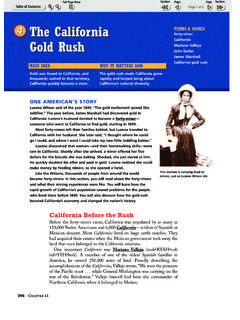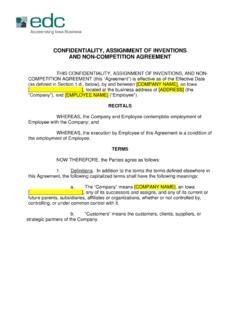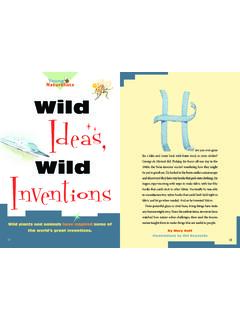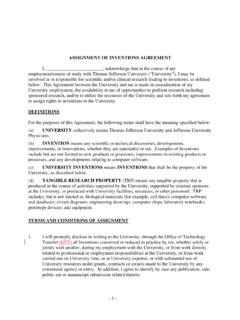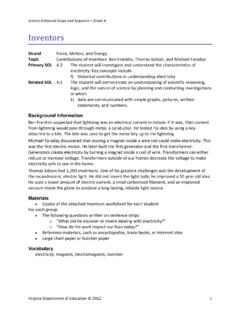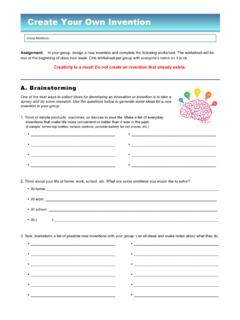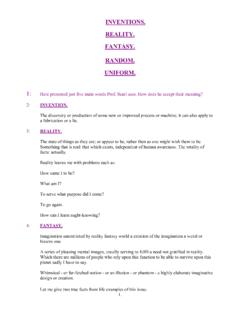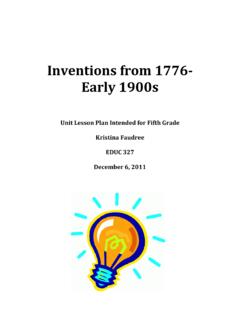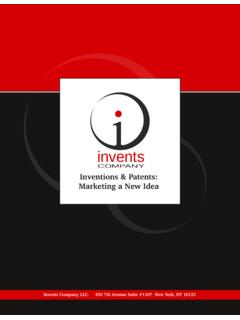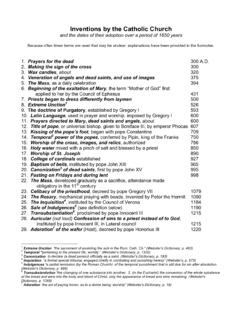Transcription of 1 Early Industry and Inventions - Mr Thompson's Classroom
1 National and Regional Growth325 Free Enterprise and FactoriesThe War of 1812 brought great economic changes to the United sowed the seeds for an Industrial Revolution like the one begun inBritain during the late 18th century. During the Industrial Revolution,factory machines replaced hand tools, and large-scale manufacturingreplaced farming as the main form of work. For example, before theIndustrial Revolution, women spun thread and wove cloth at home usingspinning wheels and hand looms. The invention of such machines as thespinning jenny and the power loom made it possible for unskilled work-ers to produce cloth.
2 These workers, who were often children, could pro-duce more cloth, more factory systembrought many workers and machines togetherunder one roof. Most factories were built near a source of water to powerthe machines. People left their farms and crowded into cities where theONE AMERICAN S STORYIn 1789, the Englishman Samuel Slatersailed to the UnitedStates under a false name. It was illegal for textile workers likehim to leave the country. Britain wanted no other nation tocopy its new machines for making thread and cloth. But Slaterwas going to bring the secret to America.
3 When he got to NewYork, he wrote a letter to Rhode Island investor Moses VOICE FROM THE PASTA few days ago I was informed that you wanted a manager of cotton spinning .. in which business I flatter myself that I can give the greatest satisfaction, in makingmachinery, making good yarn, either for stockingsor twist,as any that is made in Slater,quoted in Samuel Slater: Father of AmericanManufacturesWith Brown s backing, Slater built the first successful water-poweredtextile mill in America. You will learn in Section 1 how the developmentof industries changed the ways Americans lived and Industry andInventionsSamuel Slater s mill waslocated in Pawtucket,Rhode Industry andInventions11 New machines and factories changedthe way people lived and worked inthe late 1700s and Early industrial development thatbegan more than 200 years agocontinues IDEAWHY IT MATTERS NOWTERMS & NAMESS amuel SlaterIndustrialRevolutionfactory systemLowell millsinterchangeablepartsRobert FultonSamuel F.
4 B. Morse324-329US8P R U3C11S1 11/26/02 2:43 PM Page 325factories were. They worked for wages, on a set schedule. Their way oflife changed, and not always for the Americans, such as Thomas Jefferson, did not want the UnitedStates to industrialize. But the War of 1812 led the country in thatdirection. Because the British naval blockade kept imported goods fromreaching shores, Americans had to start manufacturing their owngoods. The blockade also stopped investors from spending money onshipping and trade.
5 Instead, they invested in new American advantage of the country s free enterprise system, Americanbusinessmen built their own factories, starting in New England. Thesebusinessmen and their region grew Come to New EnglandNew England was a good place to set up factories for several needed water power, and New England had many fast-movingrivers. For transportation, it also had ships and access to the ocean. In addi-tion, New England had a willing labor force. The area s first factory work-ers were families who were tired of scraping a living from their stony Slater built his first spinning mill in Pawtucket, Rhode Island,in 1790.
6 He hired eight children between the ages of 7 and 12, paying thema low wage. Later, he built a larger mill and employed whole families. AsSlater influenced others to start mills, his family system of employmentspread through Rhode Island, Connecticut, and southern Lowell Mills Hire WomenIn 1813, the American textile Industry leaped forward when FrancisCabot Lowell built a factory in Waltham, in eastern factory not only spun raw cotton into yarn, but wove it into clothon power looms. Lowell had seen power looms inEnglish mills and had figured out how to build Samuel Slater, he had brought secrets to Waltham factory was so successful that Lowelland his partners built a new factory town, Lowell, nearthe Merrimack and Concord rivers.
7 The Lowell mills,textile mills in the village, employed farm girls wholived in company-owned boardinghouses. Lowellgirls worked 121 2-hour days in deafening VOICE FROM THE PASTAt first the hours seemed very long .. and when I wentout at night the sound of the mill was in my ears .. You know that people learn to sleep with the thunder ofNiagara [falls] in their ears, and a cotton mill is no worse,though you wonder that we do not have to hold ourbreath in such a noise. Letters from Susan, quoted in the Lowell Offering326 CHAPTER11 Vocabularyindustrialize: todevelop factoriesLowell girlspublished a RecognizingEffectsHow didthe War of 1812cause economicchanges inAmerica?
8 A. AnswerItblocked shipping,forcing Americansto manufacturetheir own goodsand to invest inbusinesses otherthan in 1826,the town wasnamed forLowell, who diedin R U3C11S1 11/26/02 2:43 PM Page 326 Young women came to Lowell in spite of the noise. In the Early years,wages were high between two and four dollars a week. Older womensupervised the girls, making them follow strict rules and attend read books, went to lectures, and even published a literary maga-zine the Lowell they worked for only a few years,until they married.
9 By the 1830s, however, falling profits meant thatwages dropped and working conditions worsened for the Lowell Lowell mills and other Early factories ran on water built after the 1830s were run by more powerful steam steam engines used coal and wood, not fast-moving water, fac-tories could be built away from rivers and beyond New New Way to ManufactureNew manufacturing methods changed the style of work in other indus-tries besides the textile Industry . In 1797, the government hired theinventor Eli Whitney to make 10,000 muskets for the army.
10 He was tohave the guns ready in two years. Before this time, guns were made oneat a time by gunsmiths, from start to finish. Each gun differed a part broke, a new part had to be created to match the broken sought a better way to make guns. In 1801, he went toWashington with a box containing piles of musket parts. He took a partfrom each pile and assembled a musket in seconds. He had just demon-strated the use of interchangeable parts,parts that are exactly and Regional Growth327captionB. ContrastingHow did theLowell mills differfrom Slater s mill?

